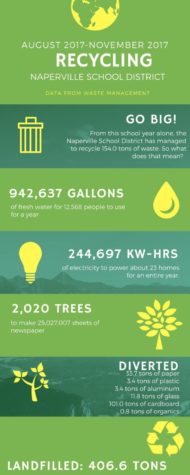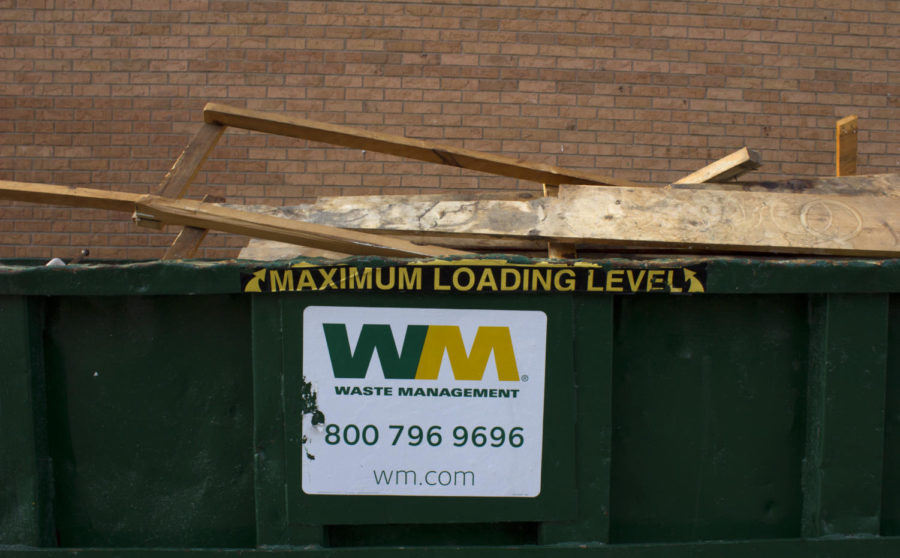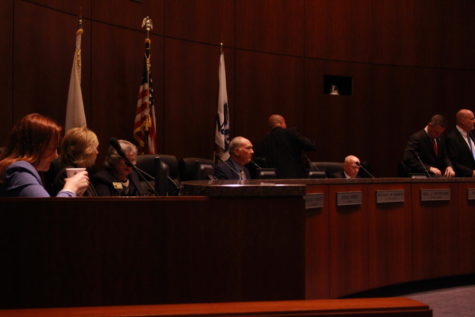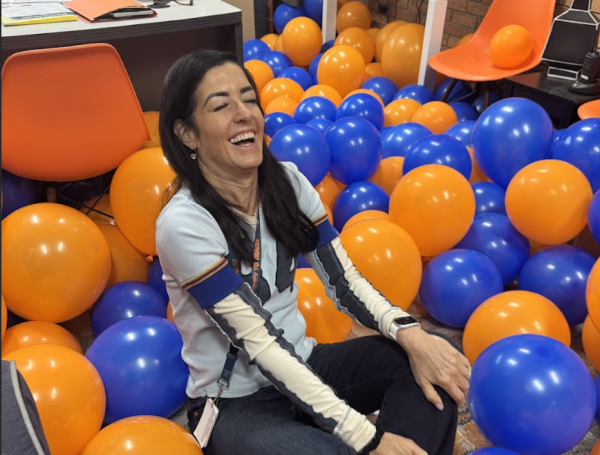A broken cycle? A look into the fate of recycled products in District 203
Photo by Jacob de Waard
Scrap wood sits in a recycling bin located near the auditorium entrance. In July 2017, Waste Management signed a three-year deal to provide Naperville North High School with a dumpster and a truck to collect the recycling.
As the bell ends lunch, you shoulder your backpack, throw away your garbage, and toss your nearly empty Gatorade bottle in the recycling bin. You pat yourself on the back for helping the environment. Your bottle lies there, cap slightly unscrewed, the bright red liquid bleeding on to the other plastic bottles, aluminum cans and paper products. After being collected and tossed into one of the dumpsters outside of Naperville North High School, a truck brings the recyclables to a sorting center. Unbeknownst to you, that entire truck load would be forced to end up in landfills, plagued by contamination from one little bottle.
It’s clear that NNHS students recycle, but do they understand how the fragile process really functions?
When it comes to our environmental footprint, recycling seems to be the easiest way to make a difference. Nonetheless, the effectiveness of the entire process is threatened by the very students who keep it moving. According to the “Recycle Right. Recycle Often” website by Waste Management, 69 percent of plastic bottles and 49 percent of aluminum cans end up in landfills due to contamination. As paradoxical as it sounds, recycling too much can be detrimental to the process as a whole.
Contamination occurs when a recycled material has leftover food or drink product on it, making it impossible to be sanitary to recycle. For instance, a soggy pizza box covered in grease can spoil not only that item, but all the other items in that load.
Laura Pall, the Major Account Manager of Waste Management, explained the impact can extend past the time of pick up.
“Naperville North’s recycling, for instance, might be in that truck, but they go to many other places to fill one truck up, so if there is contamination… that whole load is considered contaminated and we have to take it to a landfill,” Pall said.
A common misconception centers around the recycling arrow symbol that appears printed on many materials, also known as a “Mobius Loop.” A product must have at least 60 percent access to local recycling programs in the U.S. in order to include this symbol, but this does not necessarily mean that the Naperville Material Recovery Facilities will be able to process the product at the current time. Other commonly recycled products that can actually damage the process include plastic wrap, bubble wrap, plastic sandwich bags and freezer bags. As a rule of thumb, most plastic bottles, cans, paper and cardboard are recyclable in the Naperville area.

But that doesn’t mean it’s always getting done. Throughout the cafeterias, there are many NNHS students who do know the proper way to recycle. One student explained how she makes sure to clean out bottles before tossing them in the recycling bin. Nonetheless, there are still common misconceptions about the process. For instance, the recycling bins found in NNHS classrooms can contain a variety of materials, not just paper, unbeknownst to many.
Surprisingly, the Learning Commons, a popular space for studying and socializing alike, is dotted with garbage cans during lunch periods, with no recycling bins in sight. In order to recycle here, students must locate one of only two bins underneath the printers.
As of July 2017, Naperville School District 203 holds a service contract with Waste Management. This contract asserts that Waste Management will provide a dumpster for NNHS’s recycling as well as a truck to collect the recycling. The contract will last three years, with possible extensions for up to two years. Both the recycling program and the refuse program will cost an estimated $170,000 in this year alone for the district as a whole.
Kevin Ory, the Building & Grounds Operations Manager for the district, described how the contractors determine the budget for that year.
“We know what size containers we have, and we’re charged by the size of the container and how often that container is picked up, so we can determine pretty closely what our cost is,” Ory said.
After being picked up by a Waste Management truck, the recycling will feed into a process called single-stream recycling. This means that instead of being separated by the depositor, all recyclables are mixed into one recycling bin.
This assortment makes its first stop at Advanced Disposal’s Roscoe Transfer Center, where it is consolidated and transferred to larger trucks for delivery to the next step. Transfer centers reduce the cost of transporting goods to distant landfills and recycling facilities, in effect reducing the pick-up costs.
The journey continues as the collection travels to Resource Management in Naperville and Lakeshore Recycling Systems West Chicago Material Recovery Facility to be sorted and processed. With single stream recycling in particular, the sorting process involves impressive amounts of conveyor belts, sorting screens, magnets and other machinery to separate over nine distinct materials.
As the final piece of the puzzle, these resources are sold to manufacturers– similarly to how they would buy new materials– with supply and demand factoring into an ultimately cheaper purchasing cost. Companies and businesses will often use recycled materials in their products, which are eventually bought by consumers like NNHS students, allowing the cycle to restart. Unless a sticky red beverage finds its way into the load.
In order to sustain the positive effects of this program, the solution starts and ends with the students and staff. By knowing what can and cannot be recycled, NNHS has the ability to stop contamination in its tracks and ensure that every possible used product will end up back on the store shelves.
So go ahead and drink that refreshing bottle of Gatorade, but think twice before tossing it in a recycling bin.
Maddie Krebs and Martin Herz contributed to this report.

Elise Mulligan is ready for her senior year at Naperville North. As Editor-in-Chief of The North Star, she has big shoes to fill but is excited to help...

Emily Welp is a senior at Naperville North High School and is returning for her second year on The North Star staff and her first year as features editor....

Jacob de Waard is a senior at Naperville North High School and is the Multimedia Producer for The North Star and The NOW. Jacob was born in New Jersey...












joe valcho • Apr 3, 2020 at 2:54 pm
Excellent article and data from 2018. Is Naperville [or the conrtractor that picks it up] able to sell the recyclables currently. How much is landfilled? Are we paying for a service that has a negative carbon footprint – that is more diesel fuel burned, plus workers fuel to get to work, plus energy to transport and process the waste? Is it time to go back to the first days of recycling, where we delivered AND then sorted our recyclables?!
Good work!
Joe